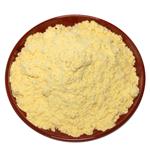Uses of Clodinafop propargyl
Nov 8,2021
Clodinafop-propargyl is a post-emergence herbicide that is absorbed by the leaves of plants. Clodinafop-propargyl converts from the ester to the active acid and then Clodinafop-propargyl inhibits the enzyme acetyl co-enzyme A carboxylase (ACCase), which is responsible for synthesizing lipids. Clodinafop-propargyl interacts with and inhibits the enzyme, acetyl co-enzyme A carboxylase (ACCase), which is essential for the production of lipids (fatty acids) needed for plant growth. Selectivity is based on the difference in the speed of herbicide breakdown in the crop versus the weeds. Clodinafop-propargyl converts from the ester form to the active acid and then to biologically inactive compounds. Grass weeds such as wild oats and wild millet cannot effectively break down clodinafop-propargyl, so they are controlled as a lethal dose accumulates at the meristematic growing points. A safer, cloquintocet-mexyl, is added to the formulation to accelerate the rate of clodinafop break down in wheat, thus preventing the accumulation of a lethal dose [1-3]. Treatment causes yellowed leaves, stunted growth and death within eight days of application.

Uses
Clodinafop-propargyl is a member of the aryloxyphenoxy propionate chemical family. It acts as a systemic herbicide that acts on post-emergent weeds such as selected grasses. It does not act on broad leaved weeds. It is applied to the foliar parts of the weeds and is absorbed through the leaves. This foliar acting grass weed killer is translocated to the meristematic growing points of the plant where it interferes with the production of fatty acids required for plant growth. Grass weeds controlled include wild oats, rough meadow-grass, green foxtail, barnyard grass, Persian darnel, volunteer canary seed. It also provides moderate control of Italian rye-grass. It is suitable for use on the following crops – all varieties of wheat, autumn-sown spring wheat, rye, triticale and durum wheat [1-3]. Figure 1 the chemical structure of clodinafop-propargyl .
Precautions for use
The product is suitable for spring or autumn application, although the speed of action is slower in cooler conditions. It is effective against wild oats up to the six-leaf stage, allowing a wide window of application and is highly selective in wheat. The use of an additive, such as mineral oil, is recommended. The product is used with the safer, cloquintocet-mexyl, in wheat, rye and triticale [1-3]. Clodinafop-propargyl does not control broadleaf weeds, but it can be tank-mixed with a wide range of broadleaf herbicides, including bromoxynil, chlorsulfuron, fluoroxypyr, MCPA, prosulfuron, dicamba, 2,4-D, clopyralid and metsulfuron-methyl.
Toxicity and treatment
Using the tolerance for clodinafop-propargyl in/on wheat of 0.1 ppm and assuming that 100% of the U.S. wheat crop is treated with clodinafop-propargyl, the acute dietary exposure to Clodinafop-propargyl from food will occupy <1.0% of the aPAD for the U.S. population, 7.5% of the aPAD for nursing females 13 years and older, the subgroup of adult females with the highest estimated exposure, and 1.0% of the aPAD for children 1 to 6 years old, the subgroup of infants and children with the highest estimated exposure. In addition, there is potential for acute dietary exposure to Clodinafop-propargyl in drinking water. After calculating Drinking Water Levels of Concern (DWLOCs) and comparing them to the Estimated Environmental Concentrations (EECs) for surface and ground water, EPA does not expect the aggregate exposure from food and drinking water to exceed 100% of the aPAD [2].
Using an anticipated residue in wheat of 0.07 ppm (the sum of the limits of quantitation of clodinafop-propargyl and its acid metabolite, CGA-193469) and assuming that 4% of the U.S. wheat crop is treated with clodinafop-propargyl, EPA has concluded that exposure to Clodinafop-propargyl from food will utilize 14 % of the cPAD for the U.S. population and 32% of the cPAD for children 1 to 6 years old, the subgroup of infants and children with the highest estimated exposure. In addition, there is potential for chronic dietary exposure to Clodinafop-propargyl in drinking water. After calculating DWLOCs and comparing them to the EECs for surface and ground water, EPA does not expect the aggregate exposure from food and drinking water to exceed 100% of the cPAD[2].
In accordance with the EPA Proposed EPA Weight-of-the-Evidence Categories, August 1999, the Agency's Cancer Assessment Review Committee (CARC) classified clodinafop-propargyl as "likely to be carcinogenic to humans" by the oral route based on the occurrence of prostate tumors in male rats, ovarian tumors in female rats, and liver tumors in both sexes of mice, as well as blood vessel tumors in female mice. For the quantification of human cancer risk, the CARC recommended a linear low-dose extrapolation approach based on the most potent of these tumor types. This approach is supported by possible genotoxic potential and the lack of confirmation of the mode of action of clodinafop-propargyl. The most potent unit risk, Q *(mg/kg/day)-1, of those calculated for clodinafop-propargyl is that for male mouse liver 1 benign hepatoma and/or carcinoma combined tumor rates at 0.129 (mg/kg/day)-1 in human equivalents [2].
References
1.PPDB: pesticide properties database
2.EPA, 2000. Name of Chemical: Clodinafop-propargyl Reason for Issuance: Conditional Registration Date Issued: June 6, 2000 Environmental Protection and Toxic Substances Agency.
3.S.H.E. Hamada and M. F. Abdel-Lateef and A.E. Abdelmonem and R.M.A. El-Kholy and A.A.R. Helalia. "Efficiency of certain clodinafop-propargyl formulations in controlling annual grassy weeds in wheat." Annals of Agricultural Sciences (2013).
- Related articles
- Related Qustion
The price ratio of D-proline and L-proline is quite different. Therefore, D-proline is prepared from L-proline through asymmetric transformation. Proline has a very important meaning.....
Nov 5,2021Amino Acids and DerivativesClindamycin Phosphate?is the phosphate salt form of?clindamycin, a semi-synthetic, chlorinated Betulinic acid is a pentacyclic triterpenoid that is?lupane?having a double bond at position 20(29).....
Nov 9,2021Biochemical EngineeringClodinafop-propargyl
105512-06-9You may like
Clodinafop-propargyl manufacturers
- Clodinafop-propargyl
-

- $100.00 / 1KG
- 2023-01-31
- CAS:105512-06-9
- Min. Order: 1KG
- Purity: 99%
- Supply Ability: 5000KG
- Clodinafop-propargyl
-

- $11.00 / 1KG
- 2019-07-06
- CAS: 105512-06-9
- Min. Order: 1KG
- Purity: 99%
- Supply Ability: 1000KG




